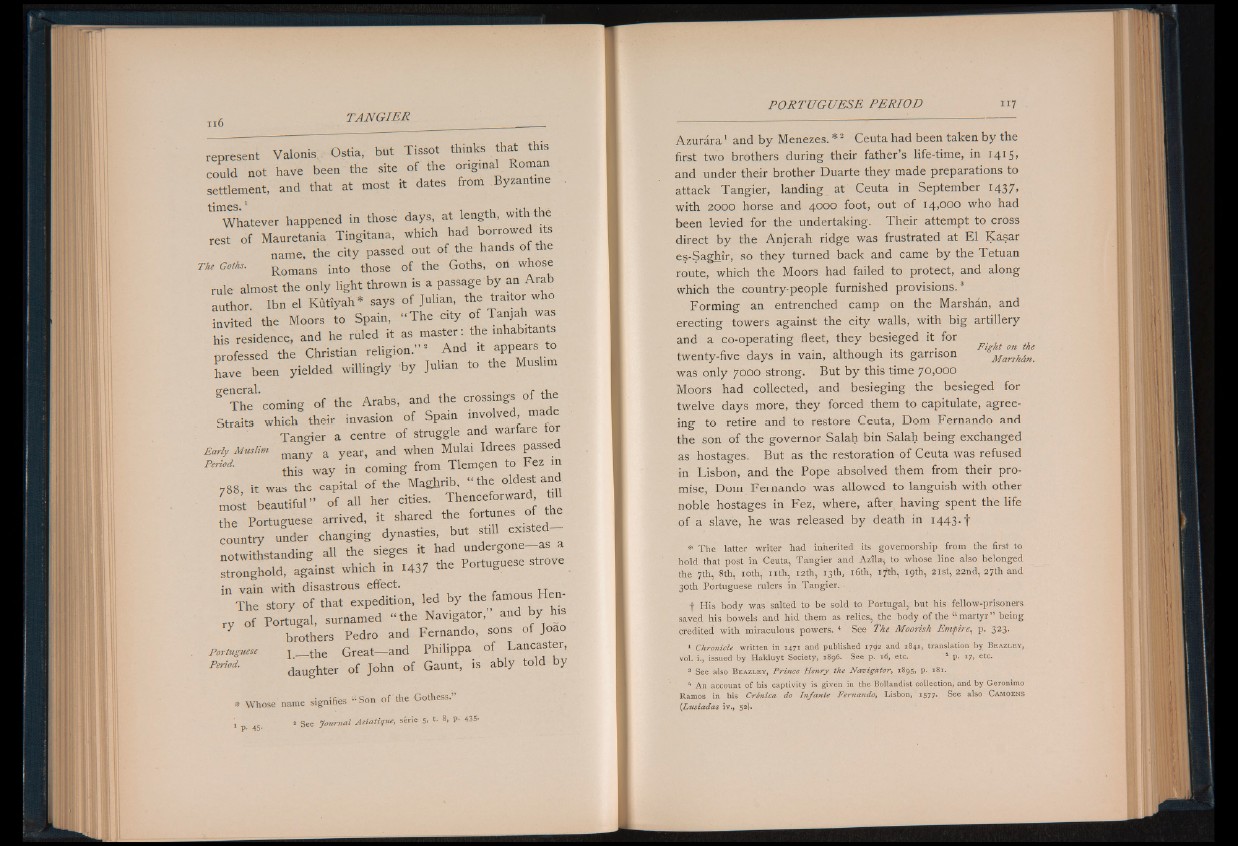
represent Valonis Ostia, but Tissot thinks hat this
could not have been the site of the original Roman
settlement, and that at most it dates from Byzantine
Whatever happened in those days, at length, with the
rest o f Mauretania Tingitana, which had borrowed its
name, the city passed out o f the hands o f the
The Goths. Romans into those o f the Goths, oil whose
rule almost the only light thrown is a passage b y an Arab
author Ibn el K u tiy ah * says o f Julian, the traitor who
invited the Moors to Spain, “ T h e city o f Tanjah was
his residence, and he ruled it as master: the inhabitants
orofessed the Christian religion.” 2 A n d it appears o
have been yielded willingly b y Julian to the Muslim
g' T h i coming o f the Arabs, and the crossings o f the
Straits which their invasion o f Spain involved made
Tangier a centre o f struggle and warfare for
Early Muslim many a year, and when Mulai Idrees passe
P e r i o d ' this w a y in coming from Tlemgen to F e z in
788, it was the capital o f the Maghrib “ the oldest and
L o s t beautiful'' o f all her cities. Thenceforward t,U
the Portuguese arrived, it shared the or unes ^
country under changing dynasties but U H i I
notwithstanding all the sieges it had undergone
stronghold, against which in i 4 3 7 the Portuguese strove
in vain with disastrous effect.
The story o f that expedition, led b y the famou1 Henry
o f Portugal, surnamed “ the Navigator, and b y Ins
brothers Pedro and Fernando, sons o f Joa
Portuguese I.— the Great— and Philippa o f Lancaster,
P e r i o d - of Tohn o f Gaunt, is ably told b y
* Whose name signifies “ Son of the Gothess.”
j 1 gee Journal Asiatique, série 5, t. 8, p. 435-
POR TU GU ESE PER IOD 117
Azuràra1 and by Menezes. * 2 Ceuta had been taken by the
first two brothers during their father’s life-time, in 1415,
and under their brother Duarte they made preparations to
attack Tangier, landing at Ceuta in September 1437,
with 2000 horse and 4000 foot, out of 14,000 who had
been levied for the undertaking. Their attempt to cross
direct by the Anjerah ridge was frustrated at El Kàsar
es-Saghir, so they turned back and came by the Tetuan
route, which the Moors had failed to protect, and along
which the country-people furnished provisions.3
Forming an entrenched camp on the Marshàn, and
erecting towers against the city walls, with big artillery
and a co-operating fleet, they besieged it for
. , , , . Fight on the
twenty-five days in vain, although its garrison Marshàn.
was only 7000 strong. But by this time 70,000
Moors had collected, and besieging the besieged for
twelve days more, they forced them to capitulate, agreeing
to retire and to restore Ceuta, Dom Fernando and
the son of the governor Salah bin Salah being exchanged
as hostages. But as the restoration of Ceuta was refused
in Lisbon, and the Pope absolved them from their promise,
Dom Fernando was allowed to languish with other
noble hostages in Fez, where, after having spent the life
of a slave, he was released by death in 1443. f
* The latter writer had inherited its governorship from the first to
hold that post in Ceuta, Tangier and Azila, to whose line also belonged
the 7th, 8th, 10th, nth, 12th, 13th, 16th, 17th, 19th, 21st, 22nd, 27th and
30th Portuguese rulers in Tangier.
t His body was salted to be sold to Portugal, but his fellow-prisoners
saved his bowels and hid them as relics, the body of the “ martyr” being
credited with miraculous powers. 4 See The Moorish Empire, p. 323.
* Chronicle written in 1471 and published 17^2 and 1841, translation by B e a z le y ,
vol. i., issued by Hakluyt Society, 1896. See p. r6, etc. 1 p. 17, etc.
3 See also Beazley, Prince Henry the Navigator, 1895, p. i8r.
4 An account of his captivity is given in the Bollandist collection, and by Geronimo
Ramos in his Crònica do Infante Fernando, Lisbon, 1577. See also Camoens
(Lusiadas iv., 52).